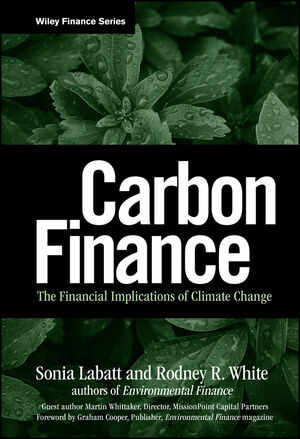Carbon Finance: The Financial Implications of Climate ChangeISBN: 978-0-471-79467-7
Hardcover
288 pages
April 2007
 |
||||||
About the Authors.
Acknowledgments.
List of Acronyms.
Chapter 1: Introduction.
Introduction.
The Changing Climate.
The Scientific Context of Climate Change.
The Political Context of Climate Change.
Corporate Climate Risk.
Regulatory Risk.
Physical Risks.
Business Risks.
Climate Policies.
Mitigation Policies.
Adaptation Measures.
Role of the Financial Services Sector.
Conclusion.
Chapter 2: The Energy Chain.
Introduction.
The Energy Chain and the Value Chain.
Carbon Policies.
Policy Approaches.
The Broader Policy Context.
National and Local Self-Sufficiency.
Impacts of Different Users and Uses on Climate Change.
Users: Business, Households, and Government.
Uses: Manufacturing, Transportation, Heating, Water, and Solid Waste.
Sources of Energy: Fossil Fuels.
Coal.
Oil 37
Gas.
Sources of Energy: Nuclear Energy.
Sources of Energy: Hydroelectric Power.
Sources of Energy: Renewables.
Traditional Biomass.
Wind Energy.
Solar Energy.
Tidal Energy and Wave Energy.
Modern Biomass and Biofuels.
Geothermal Energy.
Key Issues.
A Hydrogen Economy Based on Fuel Cells?
Carbon Sequestration.
Unintended Discharges.
Financing the Transformation of the Energy Chain: The Role of Venture Capital.
Conclusion.
Chapter 3: Regulated and Energy-Intensive Sectors.
Introduction.
Power Industry.
Integrated Oil and Gas Industry.
Government Mandates.
Physical Capital.
Restricted Access to Oil and Gas Reserves.
The Coming Age of Gas, and Beyond.
Global Concerns Regarding Energy Security.
Transportation.
Automotive Industry.
Factors Affecting Auto Manufacturers’ Carbon Profile.
Aviation.
Cement.
Competitive Implications of Climate Risk in Regulated and Energy-Intensive Sectors.
Conclusion.
Chapter 4: The Physical Impacts of Climate Change on the Evolution of Carbon Finance.
Introduction.
Physical Impacts on Unregulated Sectors.
Water Supply and Treatment.
Agriculture.
Forestry.
Fisheries.
Real Property and Production Facilities.
Transportation.
Tourism.
Municipalities.
The Built Environment.
Physical Impacts on Carbon-Regulated Sectors.
Electric Power.
Oil and Gas Producers.
Financial Services.
Banking.
Investment.
Insurance.
Conclusion.
Chapter 5: Institutional Investors and Climate Change.
Introduction.
Institutional Investors: Size and Global Reach.
Environmental Reporting.
Corporations.
Institutional Investors.
Corporate Environmental Reporting.
New Era of Fiduciary Responsibility for Institutional Investors.
Investment Decision Making.
Active Engagement.
Shareholder Resolutions and Proxy Voting.
Mutual Funds.
New Momentum in the Corporate World.
Barriers to the Financial Consideration of Climate Change.
Institutional Investors and Climate Change.
Institutional Investors’ Group on Climate Change (IIGCC).
Carbon Disclosure Project (CDP).
The Equator Principles.
Investor Network on Climate Risk (INCR).
Conclusion.
Chapter 6: Emissions Trading in Theory and Practice.
Introduction.
How Carbon Is Traded Now.
The Kyoto Protocol.
The Chicago Climate Exchange.
The European Union Emission Trading Scheme.
The Price of Carbon in the EU ETS.
Countries outside Europe with Kyoto Caps.
Carbon Markets in the United States and Australia.
Setting up the Clean Development Mechanism and Joint Implementation.
The Role of Carbon Funds, Carbon Brokers, and Exchanges.
Key Issues.
Verification—Protocols for Measuring Emission Reductions.
Controlling the Sale of "Hot Air."
The Quality and Price of Carbon Credits.
Enforcing Compliance.
Integrating the Various Trading Platforms.
The CDM Bottleneck.
Extending the Time Horizon beyond 2012.
Extending Carbon Caps to Uncapped Parties.
The Carbon Offset Market.
The Role of Insurance in Emissions Trading.
Issues for Dispute Resolution.
Conclusion.
Chapter 7: Climate Change and Environmental Security: Individuals, Communities, Nations.
Introduction.
Direct Effect of Extreme Weather Events.
Health Effects of Climate Change.
Direct Effects of Temperature Extremes: Heat Waves and Cold Spells.
Indirect Effects of Climate Change: Vector-Borne Infectious Diseases.
Polar Regions.
Climate Systems and National Sovereignty.
The Gulf Stream and the Thermohaline Current.
The El Ni ˜ no/Southern Oscillation (ENSO).
Conclusion.
Chapter 8: Adapting to Adverse and Severe Weather.
Introduction.
Adverse Weather: The Role of Weather Derivatives.
Weather Derivative Instruments.
Examples of Weather Derivative Contracts.
Current Status of Weather Markets.
Constraints on the Weather Derivatives Market.
Severe Weather: The Role of Catastrophe Bonds.
The Structure of a Catastrophe Bond.
Catastrophe Bonds and Carbon Finance.
Conclusion.
Chapter 9: Key Players in the Carbon Markets by Martin Whittaker, guest author.
Introduction.
Basic Elements of the Market.
EU ETS Trading.
Clean Development Mechanism (CDM) and Joint Implementation (JI) Projects.
Intermediaries, Speculators, and Professional Services.
Key Private-Sector Players.
Compliance Participants.
Commercial Banks.
Carbon Funds.
Speculative Investors.
Project Developers and Aggregators, Consultants.
Equity Research.
Carbon Brokers.
Exchanges.
Credit Rating Agencies.
Insurers.
Key Players from the Public Sector.
National Governments.
National Business Associations.
Multilateral Banks.
Information Services.
Professional Services.
Accounting.
Legal.
New Horizons for the Carbon Market.
Carbon as an Asset Class.
Mainstreaming into Project Finance.
Conclusion.
Chapter 10: Carbon Finance: Present Status and Future Prospects.
Introduction.
Trading Volumes in Carbon and Weather Markets.
Carbon Markets.
Weather Derivatives.
What Can Be Traded Where? (and What Cannot?).
Price Discovery.
The Evolution of Products for Carbon Finance.
Litigation over Responsibility for Climate Change.
Is Carbon Finance Likely to Help Us Avert Dangerous Levels of Climate Change?
Carbon Finance within the Broader Field of Environmental Finance.
Conclusion.
Endnotes.
Web Sites.
References.
Index.



